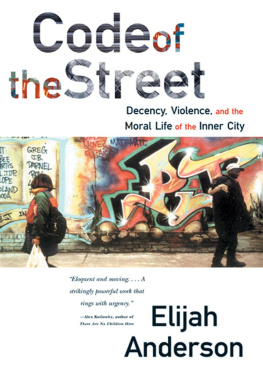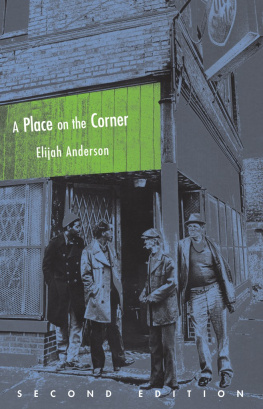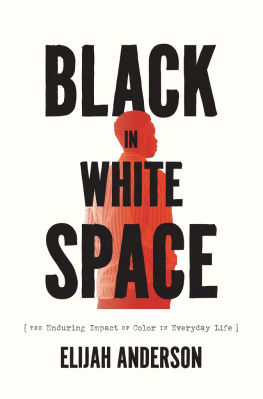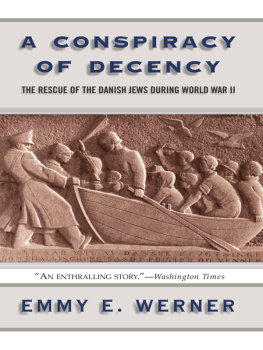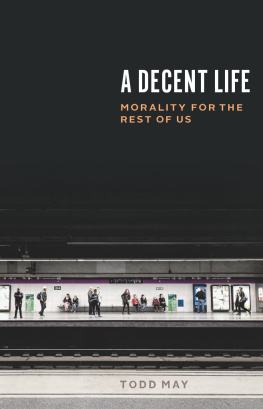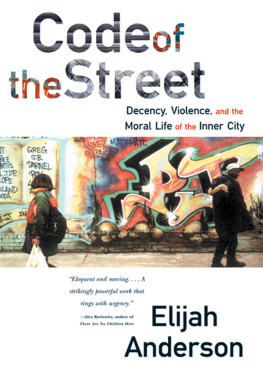Elijah Anderson - Code of the Street: Decency, Violence, and the Moral Life of the Inner City
Here you can read online Elijah Anderson - Code of the Street: Decency, Violence, and the Moral Life of the Inner City full text of the book (entire story) in english for free. Download pdf and epub, get meaning, cover and reviews about this ebook. year: 1999, publisher: W. W. Norton & Company, genre: Home and family. Description of the work, (preface) as well as reviews are available. Best literature library LitArk.com created for fans of good reading and offers a wide selection of genres:
Romance novel
Science fiction
Adventure
Detective
Science
History
Home and family
Prose
Art
Politics
Computer
Non-fiction
Religion
Business
Children
Humor
Choose a favorite category and find really read worthwhile books. Enjoy immersion in the world of imagination, feel the emotions of the characters or learn something new for yourself, make an fascinating discovery.
- Book:Code of the Street: Decency, Violence, and the Moral Life of the Inner City
- Author:
- Publisher:W. W. Norton & Company
- Genre:
- Year:1999
- Rating:5 / 5
- Favourites:Add to favourites
- Your mark:
- 100
- 1
- 2
- 3
- 4
- 5
Code of the Street: Decency, Violence, and the Moral Life of the Inner City: summary, description and annotation
We offer to read an annotation, description, summary or preface (depends on what the author of the book "Code of the Street: Decency, Violence, and the Moral Life of the Inner City" wrote himself). If you haven't found the necessary information about the book — write in the comments, we will try to find it.
Code of the Street: Decency, Violence, and the Moral Life of the Inner City — read online for free the complete book (whole text) full work
Below is the text of the book, divided by pages. System saving the place of the last page read, allows you to conveniently read the book "Code of the Street: Decency, Violence, and the Moral Life of the Inner City" online for free, without having to search again every time where you left off. Put a bookmark, and you can go to the page where you finished reading at any time.
Font size:
Interval:
Bookmark:
A Place on the Corner
Streetwise: Race, Class, and Change in an Urban Community
DECENCY, VIOLENCE, AND THE MORAL LIFE OF THE INNER CITY
W. W. NORTON & COMPANY NEW YORK / LONDON
Copyright 1999 by Elijah Anderson
All rights reserved
For information about permission to reproduce selections from this book, write to Permissions, W. W. Norton & Company, Inc., 500 Fifth Avenue, New York, NY 10110.
Library of Congress Cataloging-in-Publication Data
Anderson, Elijah.
Code of the street: decency, violence, and the moral life of the inner city / Elijah Anderson.
p. cm.
Includes bibliographical references.
ISBN: 978-0-393-07038-5
1. Afro-AmericansPennsylvaniaPhiladelphiaSocial conditions. 2. Afro-AmericansPennsylvaniaPhiladelphiaSocial life and customs. 3. Inner citiesPennsylvaniaPhiladelphia. 4. Philadelphia (Pa.)Social conditions. 5. Philadelphia (Pa.)Social life and customs. I. Title.
F158.9.N4A52 1999
303.3'3'0896073074811dc21
98-36800
CIP
W. W. Norton & Company, Inc., 500 Fifth Avenue, New York, N.Y. 10110
http://www.wwnorton.com
W.W. Norton & Company Ltd., 10 Coptic Street, London WC1A 1PU
This book is dedicated to the cherished memory of:
Samuel
Roosevelt
Ed Lee
Perry
Robert
Leonard
L. C., Sr.
Leighton, Sr.
James T.
David
Freddie
Charlotte
James T.
Arlene
Jesse L.
Augusta
Shang
Jerlene
J.B.
Philip
Bernice
Annette
And with profound and ardent hope for the lives and dreams of:
Sydney
Muffin
Michael Torrance
Benjamin
Timothy
Michael
Taura
Luke
Shemika
Jada
Delisa
Jamila
Carla
Billy
Terriam
Gabriele
Kendrick
Mariah
Malik
Anita
Christopher
Ruby
Robert Earl, Jr.
Joe, Jr.
Nuabe
Stacy
Camille
Caitlin
Syreeta
Fiona
Jeremy
Tamika
Terry
Wilson (Junebug), Jr.
Jesse, Jr.
Hashid
James T., Jr.
Roderick
Melanie
Anjanette
Joel
Robert T.
T HE present work grows out of the ethnographic work I did for my previous book, Streetwise: Race, Class, and Change in an Urban Community (1990). There I took up the issue of how two urban communitiesone black and impoverished, the other racially mixed and middle to upper middle classcoexisted in the same general area and negotiated the public spaces. Here I take up more directly the theme of interpersonal violence, particularly between and among inner-city youths. While youth violence has become a problem of national scope, involving young people of various classes and races, in this book I am concerned with why it is that so many inner-city young people are inclined to commit aggression and violence toward one another. I hope that lessons derived from this work may offer insights into the problem of youth violence more generally. The question of violence has led me to focus on the nature of public life in the inner-city ghetto, specifically its public social organization. And to address this question, I conducted field research over the past four years not only in inner-city ghetto areas but also in some of the well-to-do areas of Philadelphia.
In some of the most economically depressed and drug- and crime-ridden pockets of the city, the rules of civil law have been severely weakened, and in their stead a code of the street often holds sway. At the heart of this code is a set of prescriptions and proscriptions, or informal rules, of behavior organized around a desperate search for respect that governs public social relations, especially violence, among so many residents, particularly young men and women. Possession of respectand the credible threat of vengeanceis highly valued for shielding the ordinary person from the interpersonal violence of the street. In this social context of persistent poverty and deprivation, alienation from broader societys institutions, notably that of criminal justice, is widespread. The code of the street emerges where the influence of the police ends and personal responsibility for ones safety is felt to begin, resulting in a kind of peoples law, based on street justice. This code involves a quite primitive form of social exchange that holds would-be perpetrators accountable by promising an eye for an eye, or a certain payback for transgressions. In service to this ethic, repeated displays of nerve and heart build or reinforce a credible reputation for vengeance that works to deter aggression and disrespect, which are sources of great anxiety on the inner-city street.
In delineating these intricate issues, the book details not only a sociology of interpersonal public behavior with implications for understanding violence and teen pregnancy but also the changing roles of the inner-city grandmother and the decent daddy, the interplay of decent and street families of the neighborhood, and the tragedy of the drug culture. The story of John Turner brings many of these themes together. And the conversion of a role model concludes the book by further illustrating the intricacies of the code and its impact on everyday life.
In approaching the goal of painting an ethnographic picture of these phenomena, I engaged in participant-observation, including direct observation, and conducted in-depth interviews. Impressionistic materials were drawn from various social settings around the city, from some of the wealthiest to some of the most economically depressed, including carryouts, stop and go establishments, Laundromats, taverns, playgrounds, public schools, the Center City indoor mall known as the Gallery, jails, and public street corners. In these settings I encountered a wide variety of peopleadolescent boys and young women (some incarcerated, some not), older men, teenage mothers, grandmothers, and male and female schoolteachers, black and white, drug dealers, and common criminals. To protect the privacy and confidentiality of my subjects, names and certain details have been disguised.
My primary aim in this work is to render ethnographically the social and cultural dynamics of the interpersonal violence that is currently undermining the quality of life of too many urban neighborhoods. In this effort I address such questions as the following: How do the people of the setting perceive their situation? What assumptions do they bring to their decision making? What behavioral patterns result from these actions? What are the social implications and consequences of these behaviors? This book therefore offers an ethnographic representation of the code of the street, and its relationship to violence in a trying socioeconomic context in which family-sustaining jobs have become ever more scarce, public assistance has increasingly disappeared, racial discrimination is a fact of daily life, wider institutions have less legitimacy, legal codes are often ignored or not trusted, and frustration has been powerfully building for many residents.
A further aim of the ethnographers work is that it be as objective as possible. This is not easy or simple, since it requires researchers to try to set aside their own values and assumptions about what is and is not morally acceptablein other words, to jettison the prism through which they typically view a given situation. By definition ones own assumptions are so basic to ones perceptions that seeing their influence may be difficult, if not impossible. Ethnographic researchers, however, have been trained to look for and to recognize underlying assumptions, their own and those of their subjects, and to try to override the former and uncover the latter. In the text that follows, I have done my best to do so.
Font size:
Interval:
Bookmark:
Similar books «Code of the Street: Decency, Violence, and the Moral Life of the Inner City»
Look at similar books to Code of the Street: Decency, Violence, and the Moral Life of the Inner City. We have selected literature similar in name and meaning in the hope of providing readers with more options to find new, interesting, not yet read works.
Discussion, reviews of the book Code of the Street: Decency, Violence, and the Moral Life of the Inner City and just readers' own opinions. Leave your comments, write what you think about the work, its meaning or the main characters. Specify what exactly you liked and what you didn't like, and why you think so.

